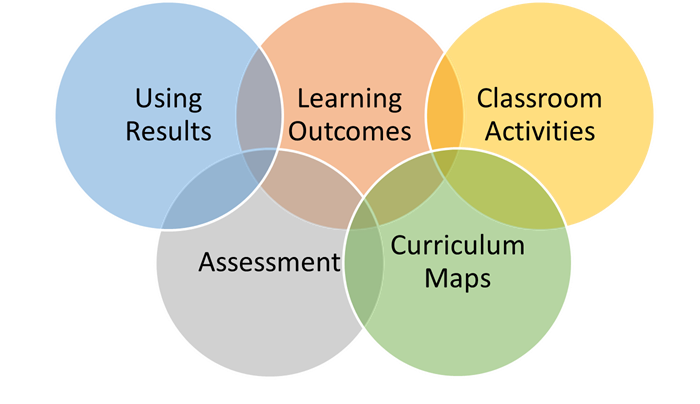Introduction: The Teaching, Learning, and Assessment Cycle: Building a Common Understanding
Think of a class you teach. What can students do that will help them in another class, on the job, or in life, as a result of successfully completing your class? You have just named a “learning outcome.” In order to achieve a learning outcome, students must master specific skills. When in your course do you ensure students can master the skills associated with the outcome you named? You have just “mapped” your outcome to the curriculum.
A few more questions. In your class, how do you communicate intended learning outcomes to students? What do you ask students to do to prove to you that they have achieved a given outcome? This is “assessment.” We often overlook the need to explicitly tell students what we expect them to learn and how we expect them to demonstrate they have learned it, yet this is a critical part of teaching and learning.
Learning outcomes, assessment, and curriculum maps are critical components of teaching and learning. It is equally important to ensure that teaching methods and classroom activities provide opportunities for students to achieve and demonstrate the learning outcomes. Finally, if we regularly use the assessment results to improve each component of our class, then we can ensure the highest quality of student learning and institutional effectiveness. These components are critical and integrated throughout any given cycle (Figure 2).

Figure 2. Critical Components of Learning
“Assessment, pedagogy, and curriculum are not mutually exclusive. In fact, they should work hand in hand, yet most institutions have yet to intentionally connect them effectively. For these reasons… higher education should strive for a culture of learning rather than a culture of assessment” (p.4).
Fulcher, Good, Coleman, & Smith (2014) |
Another question. What do you do when you realize students are not learning what you want them to learn? If you described a process to determine what might be done to help them learn better, you have described how you use results to develop improvement strategies. This is also an important part of the learning outcomes conversation. Outcomes, mapping, assessment, using assessment results, and teaching must all be used in concert to improve student learning. Fulcher, Good, Coleman, and Smith (2014)10 say it like this: “Assessment, pedagogy, and curriculum are not mutually exclusive. In fact, they should work hand in hand, yet most institutions have yet to intentionally connect them effectively.” They add, “higher education should strive for a culture of learning rather than a culture of assessment” (p.4).
Resources such as this handbook, meetings with peer faculty, and assessment workshops are part of the College’s intentional effort to merge assessment with instruction and curriculum. Such an effort is a move away from assessment for assessment’s sake and a move toward instruments and processes that inform instruction and become meaningful to all involved. In other words, these resources and opportunities are an intentional step to connect assessment, instruction, and curriculum that leads to an institutional learning culture. Many faculty members have already begun the effort to improve assessment, striving to create such a culture of learning at Palm Beach State College. Please use this handbook to join that effort.
10Fulcher, K. H., Good, M. R., Coleman, C. M., & Smith, K. L. (2014, December). A simple model for learning improvement: Weigh pig, feed pig, weigh pig. (Occasional Paper No. 23). Urbana, IL: University of Illinois and Indiana University, National Institute for Learning Outcomes Assessment.